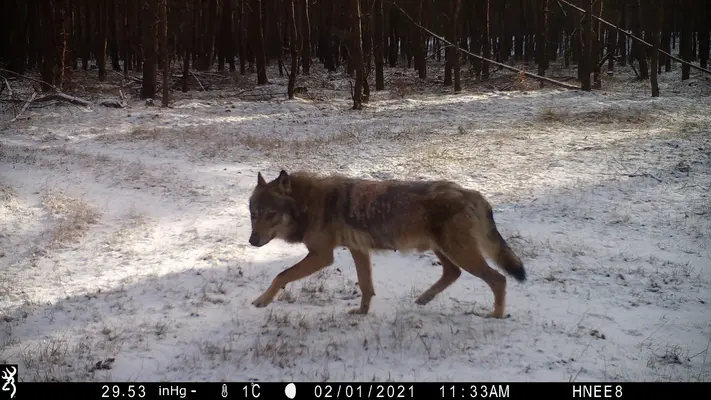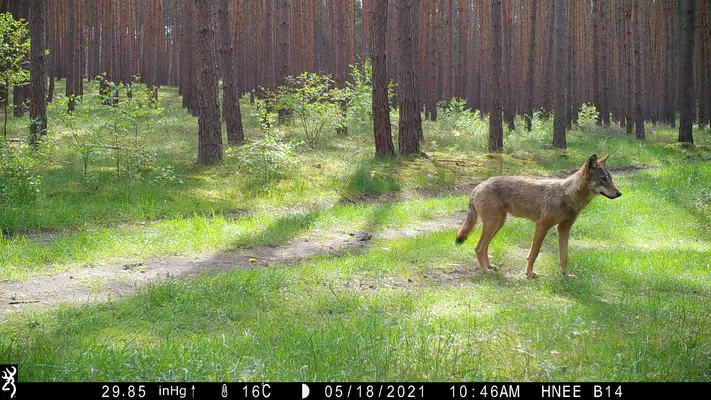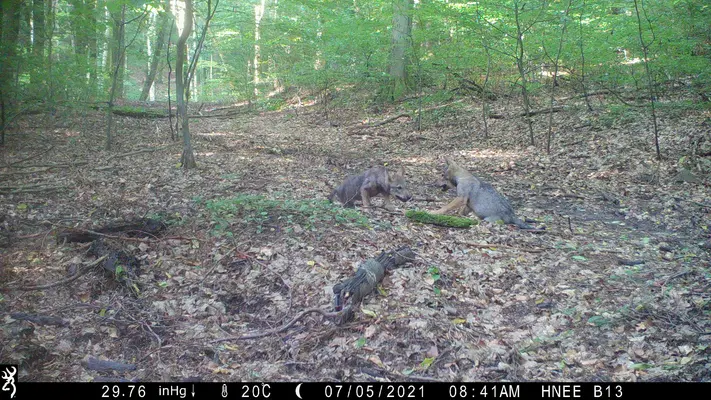Wolf offspring in the Barnim district
The Eberswalde University for Sustainable Development (HNEE) has been analysing the wolf population in the Barnim district for a year now. Two new packs have recently been established in Barnim - pups have been detected in both territories for the first time.

Male wolf of the Barnimer Heide pack with pronounced mange symptomatic.

A yearling of the Parstein-Oderberg pack in the late morning of May 2021.

Dam of the Barnimer Heide pack with a red deer run.

Playing puppies in the Parstein-Oderberg territory at the beginning of July 2021.
Now that wolves have colonised almost the entire southern part of Brandenburg, Isegrim has also been establishing itself in more and more territories in northern Brandenburg for several years. In the last monitoring year 2020/21, there were almost 60 colonised territories in the entire state.
The current colonisation process in the Barnim district has been investigated for over a year by the Eberswalde University for Sustainable Development in cooperation with the Eberswalde Forestry Department and the district's volunteer wolf commissioners. As part of an intensive monitoring programme, staff from the Department of Wildlife Biology, Wildlife Management and Hunting Management (FWWJ) have currently set up over 50 wildlife cameras in 15 hunting grounds, which automatically detect wild animals. In addition, a systematic search is being carried out for wolf solutions so that individual wolves can be identified using genetic analyses.
New territories in Barnim
"There are currently two independent wolf packs living in Barnim east of the A11 motorway," says Dr Frank-Uwe Michler, who coordinates wolf monitoring in the Barnim district. "The Barnimer Heide pack, south of Eberswalde, and the Parstein-Oderberg pack, north of the Oder-Havel Canal." In the last monitoring year 2020/2021, over 3,000 wolf images were taken by HNEE's photo trap monitoring programme. "Based on the photo trap images, we know that wolf pups were born for the first time in both territories last year," explains Prof Siegfried Rieger, Head of the FWWJ at HNEE. While the litters in 2020 were still comparatively small at two pups each, this year five (in the Barnimer Heide) and six pups (in Parstein-Oderberg) were detected by the wildlife cameras. There are currently nine wolves living in both packs.
As far as the paws can carry
In the Barnimer Heide pack, the two parent animals can be clearly identified individually on the basis of a characteristic skin condition on the photo trap images. "Based on the photo trap locations where the two adult animals were detected, we know that the wolves travel up to 30 km per night and that the territory in the Barnimer Heide extends over at least 240 km² into the Märkisch-Oderland district (Biesow, Prötzel)," reports HNEE student Nadin Edinger, who is involved in wolf monitoring.
All kinds of animals in front of the camera
"In addition to wolves, the photo traps are also used to detect other rare animal species," reports Frank-Uwe Michler. In addition to the black stork, white-tailed eagle, lesser spotted eagle and otter, a North African porcupine is regularly recorded by the wildlife cameras in the area of the Parstein-Oderberg pack. This prickly exotic animal presumably escaped from the zoo in Angermünde in spring 2020 and has been living stably in an area between Lake Parstein, Lunow-Stolzenhagen and Oderberg ever since.
Citizens are called upon to report wolf sightings and wild animal kills in the Barnim district to wolfsmonitoring@hnee.de
Note on image material
The photos available here may be used for reporting purposes. Please note the copyright notice © HNEE